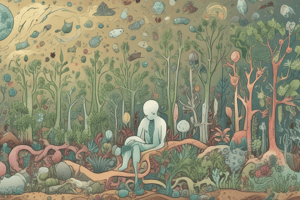Podcast
Questions and Answers
Match the following bacteria with their primary function:
Match the following bacteria with their primary function:
Azospirilium = Forms a symbiotic relationship with sugarcane and tropical grass Rhizobium = Provides nitrogen to legumes like alfalfa Nitrobacter = Converts ammonia (NH3) into nitrites (NO2) Nitrosomonas = Breaks down nitrites (NO2) into nitrates (NO3)
Match the following pathogens with their associated diseases:
Match the following pathogens with their associated diseases:
Bartonella = Causes cat scratch fever Rickettsia = Causes Rocky Mountain fever Wolbachia = Affects egg development and causes Zika virus Brucella = Causes zoonotic infections and spontaneous abortions in ungulates
Match the following bacteria with their habitat or source:
Match the following bacteria with their habitat or source:
Thiobacillus = Recycles sulfur using hydrogen, found in soil and used by miners with leach pads Zoogleal = Found in sewage, forms flock and sink Sphacontus = Found in sewage, forms flock and float Bordetella = Aerobic bacteria that is very fastidious
Match the following bacteria with their characteristics:
Match the following bacteria with their characteristics:
Match the following human pathogens with their associated diseases:
Match the following human pathogens with their associated diseases:
Match the following bacteria with their primary habitat:
Match the following bacteria with their primary habitat:
Match the following bacteria with their oxygen requirements:
Match the following bacteria with their oxygen requirements:
Match the following terms with their descriptions:
Match the following terms with their descriptions:
Match the following bacteria with their characteristics:
Match the following bacteria with their characteristics:
Match the following diseases with their respective characteristics:
Match the following diseases with their respective characteristics:
Match the following bacteria with their associated infections:
Match the following bacteria with their associated infections:
Match the following bacterial groups with their characteristics:
Match the following bacterial groups with their characteristics:
Match the following bacteria with their associated diseases:
Match the following bacteria with their associated diseases:
Match the following bacteria with their characteristics:
Match the following bacteria with their characteristics:
Match the following bacteria classification with their characteristics:
Match the following bacteria classification with their characteristics:
Match the following bacteria toxins with their effects:
Match the following bacteria toxins with their effects:
Match the following bacteria products with their uses:
Match the following bacteria products with their uses:
Match the following bacteria environmental adaptations with their characteristics:
Match the following bacteria environmental adaptations with their characteristics:
Match the following pathogens with their associated diseases:
Match the following pathogens with their associated diseases:
Match the following bacteria with their characteristics:
Match the following bacteria with their characteristics:
Match the Streptomyces species with the antibiotics they produce:
Match the Streptomyces species with the antibiotics they produce:
Match the following symptoms with the respective diseases caused by bacteria:
Match the following symptoms with the respective diseases caused by bacteria:
Match the following bacterial species with their primary impact on pregnant women:
Match the following bacterial species with their primary impact on pregnant women:
Match the bacteria with their preferred environmental conditions:
Match the bacteria with their preferred environmental conditions:
Flashcards are hidden until you start studying
Study Notes
Neisseria
- Fimbriae attach to mucus membranes
- Two human pathogens: N. gonorrhea and N. meningitis
- N. gonorrhea: 2nd most common STD/STI, infects mucus of urogenital (oral/anal) and conjunctiva, can cause PID (pelvic inflammatory)
- N. meningitis: causes meningitis, attacks the meninges and spinal cord, symptoms include stick neck, coma, and fever
Gamma Proteobacteria
- Largest and most diverse group
- Shapes, sizes, and arrangements vary
- Metabolic pathways vary
- Human pathogens: Legionella, L. monocytogenes, and Mycoplasm
Legionella
- Difficult to grow, found in water, streams, AC units, and hot tubs
- Facilitative intracellular parasite, reproduces inside and outside host
Listeriosis
- Food borne pathogen, very serious for pregnant women
- Can't eat sushi, deli meat, or unpasteurized products
- Babies can get listeria from mom in utero
Mycoplasm
- No cell wall, DNA related to Gram +
- Pleomorphic, like a fried egg
- M. pneumoniae: walking pneumonia, causes arthritis in goats
- M. hominis: urogenital infections and complications of pregnancy
Actinobacteria
- High G-C Ratio
- Common source of antibiotics
- Obligate aerobes, facultative anaerobes
- Capable of nitrogen fixation
- Fresh dirt smell
- Streptomyces: produces chlortetracycline, tetracycline, streptomyocin, and erythromycin
Mycobacterium
- Waxy walls, acid fast, very slow growing
- M. tuberculosis (TB): tubercules of connective tissue surround bacteria (white death)
- M. leprae (leprosy – Hansen's disease): still around today, causes disfiguring, circulatory problems, and nerve damage, treatable
Miscellaneous
- Chlamydia: obligate intracellular bacteria (STD), causes trachoma and pneumonia
- Spirochetes: spiral with axial filaments, move like a drill, free living, water environments, various O2 requirements
- Borrelia burgdorferi: causes Lyme disease, tick → deer → humans, symptoms: bullseye rash, fever, joint pain, and neuro issues
- Treponema: Low nutrients, makes nitrogen for others, aerobes, unusual intracellular extensions (prostheca)
- Azospirillum: Ag important, symbiotic relationship with sugarcane, tropic grass
- Rhizobium: nitrogen to legumes, alfalfa (N2 → NH4), makes amino acids and proteins
Nitrogen Cycle
- Nitrobacter: 1st step, converts ammonia (NH3) → nitrites (NO2)
- Nitrosomonas: 2nd step, breaks down nitrites more (NO2) → nitrate (NO3)
- Uses inorganic chemicals as energy source, CO2 only carbon source
Studying That Suits You
Use AI to generate personalized quizzes and flashcards to suit your learning preferences.




